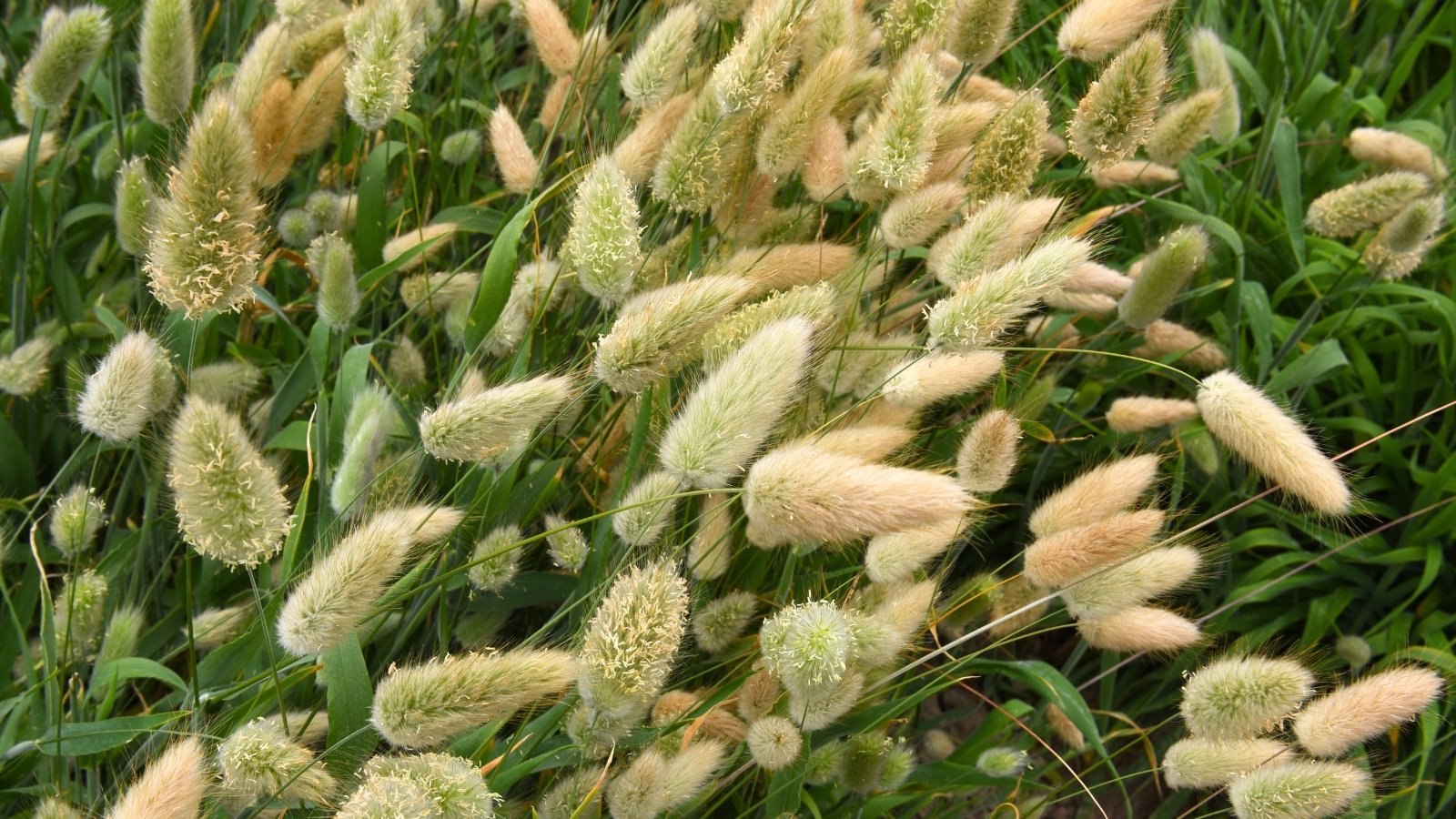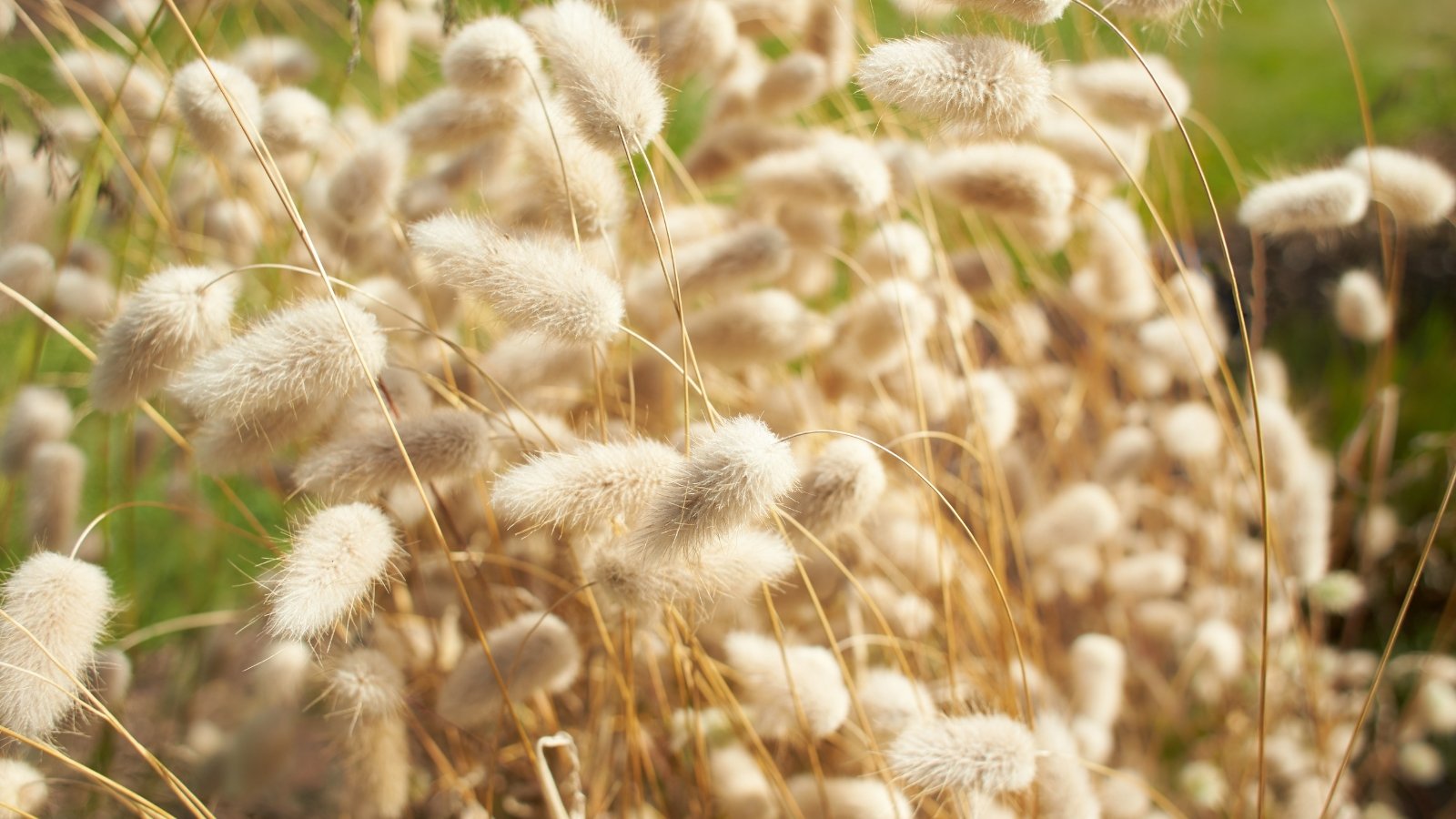How to Plant, Grow, and Care for Bunny Tails Grass
Here comes Peter Cottontail… or is that bunny tail grass? Bunny tail grass is a popular ornamental grass that is easy to grow and makes a great addition to the cutting garden as well. In this article, gardening expert Melissa Strauss will tell you what you need to know to add this fun annual to your own garden.

Contents
Gardening, especially cut flower gardening, can be a lot of work. Between pinching, fertilizing, managing pests, and maintaining the right moisture level, it can be exhausting. So, when I hear about a plant that requires little to no work and looks great in the landscape and cut arrangements, I’m all over it.
The fun little plant we are talking about today goes by the adorable name bunny tails grass. When it comes to ease of care, disease resistance, and weather tolerance, this plant ticks all the boxes. Let’s take a look at this fluffy garden wonder and talk about how to successfully grow it.
Overview

|
Plant Type
Annual Grass
Family
Poaceae
Genus
Lagurus
Species
Ovatus
|
Native Area
Mediterranean Basin
Exposure
Full sun
Height
12”-24”
Watering Requirements
Low to Moderate
|
Pests & Diseases
Mildew
Maintenance
Low
Soil Type
Sandy, loamy
Soil pH
Any
|
Bunny Tails Grass Seeds

- Charming Fluffy Flower Heads
- Effortless Cultivation
- Perfect for Floral Arrangements
- Resilience in Dry Climates
- Winter Interest
What is Bunny Tails Grass?

This grass is just about the cutest plant we’ve ever seen. This adorable ornamental is easy to grow and looks great in the garden and containers. It’s a wonderful addition to the cutting garden, as it makes a fun filler in floral arrangements. It’s also great for drying and adding to dried arrangements.
This annual plant requires very little care. Very few pests and diseases have any negative effect on it. It grows in neat clumps and doesn’t reseed aggressively, so there is little to worry about in terms of invasiveness. In short, this is a wonderful little ornamental plant with many uses in and outside the garden.
History

The origin of the name Lagurus comes from the Greek word lagos, meaning “a hare” or “a rabbit,” and oura, or “tail.” The species name ovatus comes from the Latin word ovare for ‘to lay eggs.’ This refers to the plant’s habit of dropping its seeds.
Depending on the culture, the symbolism behind this grass varies. In general, most symbolism refers to purity, love, and innocence. It is also associated with fertility, which is no surprise, given the association with rabbits!
Native Area

This fluffy grass is a coastal native that comes from the Mediterranean basin region. It grows naturally in Ukraine, Madeira, the Canary Islands, Saudi Arabia, and Crimea. It has also been naturalized in several other areas, including New Zealand and Australia, Ireland, and Great Britain. There is a scattering of naturalized plants throughout the Americas.
Characteristics

Lagurus ovatus is an ornamental in the grass or Poaceae family. It grows in dense, compact clumps of thin, grassy leaves. The linear leaves grow about one to two feet tall and are an attractive grayish-green.
It takes about 90-110 days for this plant to bloom from seed. In early summer, the fuzzy blooms will appear. The blooming time is long, lasting throughout the summer. The flowers start life a chartreuse green and don’t take on their neutral blush to ivory color until much later in the season.
You can harvest the flower heads at any time to use in floral arranging. Keep in mind that when young, they will be green. By late summer or early fall, the fluffy flower heads will have faded to nearly white, some with a hint of pink. They have a vase life of seven to ten days when they are fresh. However, many gardeners prefer to harvest them at the end of the summer and hang them to dry.
If not harvested, the flower heads will eventually drop their seeds. If you prefer for your plants to reseed, leave some flowers on the stem, only cutting what you don’t wish to go to seed. Harvesting a majority of the flowers will prevent this plant from crowding out other plants in the garden.
Uses

This fun and fluffy annual grass makes an excellent border, filling in nicely and creating a wonderful texture. In the garden, this adorable grass finds a place as an ornamental. Its compact size and bushy clumping habit make it a great plant to grow in groupings.
The plant’s use in the cutting garden has been on the rise in recent years. It makes a beautiful and whimsical addition to floral arrangements and is so easy to grow. It has long been admired and used in dried floral arrangements. The flower heads are sturdy as long as you harvest them ahead of dropping seeds. They stand the test of time as a dried flower.
Planting

As an annual, this ornamental grass needs planting yearly in the spring. In warmer climates, you can start your seeds indoors or directly sow. They should go in the ground about one to two weeks after your last expected frost date. In frost-free climates, start them anytime, as long as the soil temperature is 60°F (16°C).
In cooler climates, it’s best to get an early start. Start your seeds indoors in seed trays about six to eight weeks before your last expected frost date. You can still directly sow your seeds in cooler climates, but make sure to wait until the soil warms up. About two weeks after that last frost date should work.
You can sow groups of three seeds every 12 inches and then thin seedlings. You want to have one strong seedling every 12 inches for the nicest appearance. The more sun they get, the sooner they will bloom. Make sure your planting location has excellent drainage.
How to Grow
This ornamental grass is almost impossibly easy to grow. It’s a true plant and forget it type of plant. Its excellent drought tolerance and pest and disease resistance make it very easy to care for.
Light

While mature plants can tolerate light shade, your young plants will do their best growing and producing in full sun. These plants thrive in the bright sun and heat of summer. The more sun they get, the sooner you will see those fluffy seed heads appear.
If you grow these in a container, they will perform fine in the afternoon shade. That is, as long as they get sufficient sun early in the day. Six to eight hours of sun daily is the perfect amount for this ornamental grass.
Water

Overwatering is the thing to avoid here. This plant doesn’t like to have wet feet, as it can lead to root rot. Root rot is one of the few diseases to worry about with this annual grass, and it is preventable. When you plant the seeds, keep them lightly moistened while they germinate. Once your seedlings reach a few inches tall, reduce watering.
If you live in a climate that gets regular and consistent rain, you may not need to give any supplemental water. Once established, these plants are drought tolerant. In times of prolonged drought, a deep watering once per week will keep this fluffy grass perky. Make sure to water deeply and allow the soil to dry between waterings.
Soil

The main thing to remember when it comes to soil is proper drainage. This plant is native to coastal areas, so it prefers sandy soil. Although, it will grow well in loamy soil as long as the soil is loose. It is tolerant of salt in the soil and the air.
This grass is not picky about nutrient density or pH. If you want to skip fertilizing, mix some compost into the soil before planting. This will loosen the soil and provide plenty of nutrients for this plant to grow on. You don’t need to worry about making the soil more acidic or alkaline. This plant will handle both.
Temperature and Humidity

This is a warm climate plant that grows best in Zones 4-10. Seeds germinate best in soil that has reached 70°F (21°C). These drought-tolerant plants thrive in hot, sunny weather. This is great news for the southern cut flower gardener. Many of the flowers we grow for this purpose look kind of tired by midsummer. This plant will brave the heat like a champion.
Humidity is not very important. If you are growing this one in a very dry climate, it is likely to need more supplemental watering. In humid climates, keep an eye out for fungus, as with any plant. This grass doesn’t need any specific amount of humidity, though.
Fertilizing

Don’t worry too much about fertilizing this plant. It’s a light feeder, and fertilizing won’t make much of a difference. It’s a good idea, in general, to work some fertilizer or compost into your soil at the time of planting. That should be plenty to get your ornamental grass through the season.
Maintenance

This is an annual plant that doesn’t require pruning or much maintenance at all. Keep an eye out for fungal diseases, but there aren’t many other issues it deals with here. Keep the ground lightly moist most of the time, and make sure it gets enough sun.
Otherwise, sit back and watch it grow. When the seed heads look the way you want them to in terms of color, harvest them; that’s it!
Growing in Containers

Cultivating this ornamental grass in containers is no trouble at all. In fact, it looks great in container arrangements. This plant adds a lot of texture and personality to any grouping and enjoys good drainage.
Make sure to keep your container plants watered often. Container plants tend to dry out faster than those in the ground. Soil type is not important as long as it is loose and drains well.
Propagation

Because it is an annual, the most effective and common way to propagate this grass is from seed. You can divide plants mid-season, but they will still be annuals. To get a jump on the growing season, start your seeds about six to eight weeks ahead of time indoors. That is, before the last expected frost, as this grass is not frost-resistant.
If you want to directly sow your seeds, wait until about two weeks before that frost date to put your seeds in the ground. Plant a group of three seeds every six to twelve inches outdoors, or in each compartment of your seed tray. Keep your seeds moist while germinating and while they are young. In both cases, you should see seedlings begin to sprout in about 10-20 days.
When your seedlings get to two inches tall, thin them to one seedling every six to twelve inches. It takes between 90-110 days for the plant to mature and produce its fluffy seed heads.
Common Problems

On the whole, this grass is a sturdy plant with few issues. Pests don’t seem to care for it much, and there are very few diseases that affect this plant, either. If you aren’t seeing seed heads, it’s likely that your plant isn’t getting enough sun. Mildew can be a problem in very humid climates, so in these places, make sure that your plants have good air circulation between them.
Final Thoughts
In addition to being one of the easier annuals to work well in many forms in the garden, this grass is one of the most adorable, too! This easy-care, fast-growing annual creates texture and interest in the garden, containers, and cut flower arrangements. Give your plants plenty of sun, keep the soil lightly moist, and watch your fun, fluffy grass take off!









